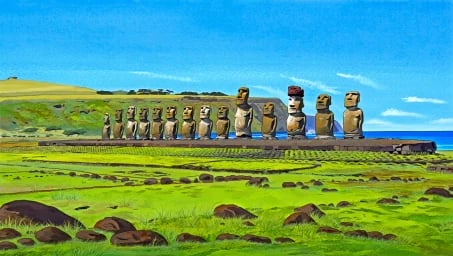Rapa Nui’s Ahu Tongariki: Fifteen Stone Sentinels Facing Eternity
UNESCOECHOES OF ELSEWHERECHILECULTUREARTISLANDSOUTH AMERICAARCHEOLOGY


Easter Island, Chile
Far out in the vast South Pacific, on a volcanic speck called Easter Island (known locally as Rapa Nui) fifteen colossal stone figures stand side by side like timeless guardians. These are the Moai of Ahu Tongariki, statues that have silently watched over the island’s heart for centuries, their solemn faces fixed toward the rising sun as if keeping ancient secrets just out of reach.
Each Moai is carved from volcanic tuff, some soaring over 10 metres tall and weighing many tonnes. Their elongated noses, heavy brows, and pursed lips give them the unmistakable air of wise old philosophers frozen mid-thought. A handful sport massive red stone hats called pukao, adding a dash of regal flair to these stoic sentinels.
The story of Ahu Tongariki is as dramatic as its statues. These Moai were toppled during tribal conflicts and then scattered further by a 1960 tsunami that ravaged the island. Yet, in the 1990s, archaeologists and locals painstakingly restored each one, piece by piece, to their rightful places along the longest ceremonial platform (ahu) on the island.
The setting couldn’t be more cinematic. Behind the Moai, volcanic hills curve gently like protective arms. Before them, the restless Pacific crashes against black lava cliffs, filling the air with salt and mystery. The magic hour here is dawn as the sun peeks over the horizon, the statues glow golden, and for a moment, you might swear they are alive, whispering stories to the wind.
Standing before these towering stone ancestors, you feel the weight of human devotion, the incredible effort to carve, transport, and raise these monoliths, all in the name of spiritual connection. The Moai aren’t mere sculptures; they are bridges between the living and the divine, storytellers etched in stone.
Though modern visitors can reach Rapa Nui by plane, stepping onto Ahu Tongariki still feels like entering a place where time slows and history hums just beneath your feet. It’s a reminder that some mysteries are carved in stone and some moments are simply meant to be revered.
Visiting Ahu Tongariki: What to Expect
Most visitors arrive via the island’s main road that hugs the coastline, where the Ahu Tongariki platform commands your attention with its row of statues standing perfectly aligned. The site is well maintained, but retains a wild, elemental feel thanks to the surrounding volcanic landscape and the ocean’s roar.
Plan to visit early in the morning or late afternoon to catch the statues in the best light. Sunrise is especially magical and far less crowded. Bring a sturdy pair of shoes if you want to explore nearby volcanic formations and lava fields, which add dramatic context to the site’s stark beauty.
Tips & Tidbits for Your Moai Encounter
Photography: The early morning golden hour is unbeatable. Use a wide-angle lens to capture the full row of statues with the ocean and hills behind.
Respect the site: These are sacred monuments with deep spiritual significance for the Rapa Nui people. Please stick to paths and avoid climbing the statues.
Learn the history: The nearby island museum offers fascinating insights into Moai construction, the island’s culture, and the mysteries still surrounding these enigmatic giants.
Combine with other sites: The island is dotted with over 900 Moai; Ahu Tongariki is the grandest but don’t miss others like Rano Raraku quarry and Anakena Beach.
Weather: The climate is subtropical oceanic. Light layers and sun protection are a must year-round.
When to Visit
Spring & Autumn: Mild temperatures and fewer tourists make for a relaxed visit.
Summer: Warm but can be busy. Perfect for exploring other island activities like snorkeling or hiking.
Winter: Cooler, wetter months, but still pleasant for sightseeing with fewer crowds.
Final Thought: Stone Stories Whispered by the Sea
Ahu Tongariki’s fifteen Moai stand as silent witnesses to a culture that revered its ancestors and reached for the divine in monumental fashion. Visiting them is like stepping into a living legend, where stone faces carved by ancient hands hold the gaze of the ocean and invite you to ponder time, mystery, and human ingenuity.
In a world that moves too fast, the Moai offer a moment of stillness. Timeless sentinels reminding us that some stories are etched in stone, meant to be marveled at, respected, and carried forward.




